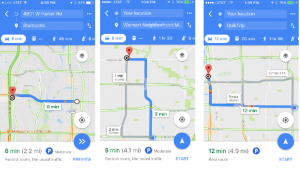Hootsuite, Buffer or something else entirely? What tool works best for your social marketing needs? Columnist Mark Traphagen explains why you may want to use more than one to schedule posts.

While there are many tools for pre-scheduling social media posts, ranging from free-but-simple to expensive-and-complex, two tools that have emerged as favorites for small to medium-sized businesses on a budget are Hootsuite and Buffer.
In this column, I’m going to show you why you might want to use both, or at least use more than one post-scheduling tool of any brand, for scheduling your social media posts.
Why Two Are Better Than One For Scheduling
The primary difference between Hootsuite and Buffer is the scope of each tool. Hootsuite is a full-featured social media management dashboard (that includes a post scheduler), while Buffer concentrates on just pre-scheduling content.

Hootsuite and Buffer share extensions for the Chrome browser.
So if both tools can schedule social media posts in advance, why would you need both of them?
At Stone Temple Consulting (my employer), we’ve found that using both tools allows us to dual-purpose our content scheduling. To be more precise, we do two kinds of social post scheduling, and using two tools lets us segregate those use cases.
In a moment, you’ll understand why we couldn’t do what we do in one tool, at least not efficiently.
(Note: Obviously, there are other tools out there that do social post scheduling. I’m using Buffer and Hootsuite as examples here of this workflow scheme, but you should be able to adapt the principles to whatever tools you use.)
Two Kinds Of Social Media Scheduling
The two kinds of pre-scheduling we do are “curation” and “new/evergreen.” Here’s what each of those means:
Curation scheduling: This scheduling type is a product of our daily online reading and social media interactions. Often we see several things we want to re-share with our followers, but we don’t want to share those out all at once.
This, of course, is a primary benefit of scheduling tools, especially those that have auto-schedule features (which both Hootsuite and Buffer do). We can one-click share all the share-worthy content we’ve found but have it post throughout the day, instead of all at once. In that way, we don’t annoy our followers by over-posting, and we keep something useful in our feeds all day.
New/Evergreen scheduling: This scheduling type is for our own content. When a piece of content is first published, we share it a little more frequently for the first week or so, to catch more audience and build some social momentum.
In addition, we maintain a list of our evergreen content, older content that still has relevance and value, and share those content pieces on a rotating basis. (For the rationale behind repeated sharing of content, and a strategy for doing it well, see my Marketing Land column, “Tweet And Repeat.”)
We then feed our most effective evergreen content into one of the post scheduling tools so that every so often these posts are being re-promoted on our social channels. In our case, we chose to use Buffer for our evergreen shares and Hootsuite for our curated shares, but either tool could be used for either one.
Our Social Sharing Workflow
Now that you understand the two different kinds of social media post pre-scheduling, you can probably figure out why using two tools is beneficial. To keep our social accounts natural and interesting, we want to have a good mix each day of a little of our own content combined with a regular flow of great curated content from others.
Why can’t we do that with one tool? We could, but not easily.
The auto-scheduling feature of each tool schedules “last-in-last-out” by default. That is, when you add a new post, the post is placed at the end of the queue.
So if we had a queue already populated with a number of curated shares, and then we fed in our evergreen content, all of that evergreen content would be placed in one block, after the curated posts. That would mess up the natural back-and-forth mix we want in our posting.
So we feed one post type into one tool and the other post type into the other. Since Buffer allows the most control in determining exactly when auto-scheduled posts are shared on each of your networks, we regularly tune the schedule there to make sure it isn’t posting too close to when Hootsuite posts.
Here’s what the scheduling function looks like in Buffer:

Using the Schedule tab in Buffer, I can set the precise times my Buffered posts will go out each day, so they don’t come too close to the posts scheduled in Hootsuite.
So our scheduled posting workflow looks like this:
- Daily: We have designated members of our team who are responsible for curating great content to our various social media accounts. When they run across something that would be good to share with our audiences, they simply click or tap the Hootsuite button (desktop extension or smartphone sharing button), modify the post as needed and select “AutoSchedule.”
- As needed: A team member regularly monitors our Buffer account to make sure each account has an adequate supply of our evergreen content. (Actually, Buffer has a convenient email alert that lets this person know when an account is running low on future content.) That team member uses our list of evergreen content to “top off” each account as needed. While currently, that team member copies and pastes into Buffer from a spreadsheet, we plan to switch over to the great tip in this post for building a drag-and-drop evergreen queue within Buffer itself (See tip #2 in the post).
Of course, as I said earlier, all of this could be done in one tool, but in order to maintain the mix of “others” vs. “our own” that we want in our feeds, we would have to manually adjust the share times of each post, after checking the calendar of already scheduled posts, or constantly edit the queue of the tool to shift scheduled posts around.
By using two tools in tandem, my team can one-click the autoschedule button of each tool for every post, and we’re good to go.
Have A Better Idea?
I’d love to hear it! If you advance-schedule both curated and original social media posts, how do you do it? Do you care about the natural mix that we try to achieve as described above? Do you have a more efficient way of achieving it than our method?
If you reply with your idea or method to one of the social shares of this post, please tag me; I’d love to accumulate those ideas for a future follow-up column. I’m @marktraphagen on Twitter and “Mark Traphagen” on most other social networks.
Some opinions expressed in this article may be those of a guest author and not necessarily Marketing Land. Staff authors are listed here.
(Some images used under license from Shutterstock.com.)
Marketing Land – Internet Marketing News, Strategies & Tips(51)
Report Post




